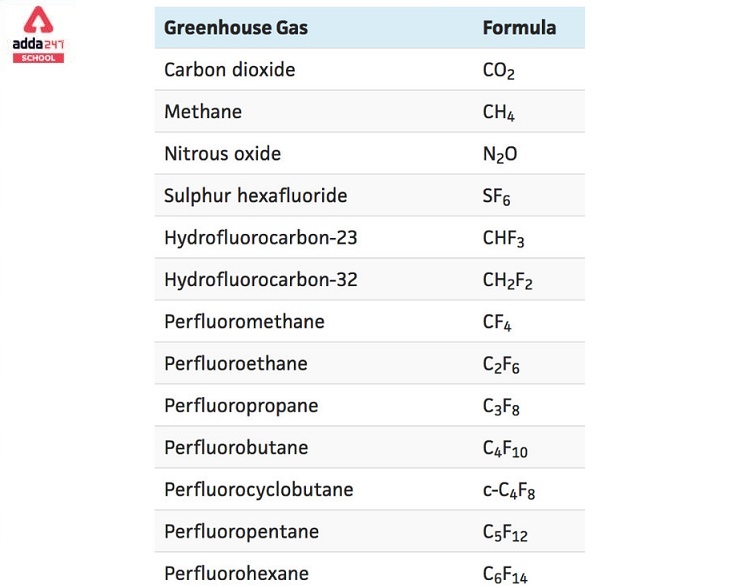Green House Gases Names
Greenhouse gases (GHGs) are gases in the Earth’s atmosphere that can trap heat and contribute to the greenhouse effect, leading to global warming and climate change. The major greenhouse gases include:
- Carbon Dioxide (CO2)
- Methane (CH4)
- Nitrous Oxide (N2O)
- Water Vapor (H2O) – The most abundant, but its concentration is not directly influenced by human activities.
- Ozone (O3)
- Chlorofluorocarbons (CFCs)
- Hydrochlorofluorocarbons (HCFCs)
- Hydrofluorocarbons (HFCs)
- Perfluorocarbons (PFCs)
- Sulfur Hexafluoride (SF6)
These gases have varying global warming potentials (GWPs), meaning they have different abilities to trap heat in the Earth’s atmosphere. Carbon dioxide, for instance, is the most significant greenhouse gas in terms of its contribution to global warming, while methane and nitrous oxide are also potent greenhouse gases, albeit in smaller concentrations. Efforts to mitigate climate change often focus on reducing emissions of these greenhouse gases.
Green House Gases
GHG or GhG are common abbreviations for greenhouse gases. A greenhouse gas is a substance that absorbs and emits radiant energy in the infrared spectrum. As a result, the greenhouse effect is created. Water vapour, carbon dioxide, methane, nitrous oxide, and ozone are the principal greenhouse gases in Earth’s atmosphere; also, without these greenhouse gases, the average temperature of Earth’s surface would be around 18 °C rather than the current average of 15 °C. Greenhouse gases can be found in the atmospheres of Venus, Mars, and Titan.
Since 1750, when the Industrial Revolution began, human activities have raised carbon dioxide levels in the atmosphere. This increase appears to have occurred despite the fact that diverse natural carbon sinks in the carbon cycle have absorbed more than half of the emissions.
Temperatures could rise by 2 degrees Celsius if current greenhouse gas emission rates continue. The Intergovernmental Panel on Climate Change of the United Nations has stated that it is the top limit for avoiding “dangerous” levels by 2050. The fact that fossil fuel burning, mostly coal, petroleum, and natural gas, accounts for the great bulk of anthropogenic carbon dioxide emissions, with additional contributions from deforestation and other changes in land use, is alarming in and of itself.
Read More:
- Vermicompost / Vermicomposting: Meaning, Process, Price
- The Biggest/Largest Country In The World
- Respiratory System: Parts, Function, Organs And Diseases
- Green Revolution In India
- One Word Substitution
Greenhouse Gases Examples
greenhouse gases examples are given below
- Carbon dioxide (CO2)
- Methane (CH4)
- Nitrous oxide (N2O)
- Industrial Greenhouses gases:
- Hydrofluorocarbons (HFCs)
- Perfluorocarbons (PFCs)
- Sulfur hexafluoride (SF6)
- Nitrogen trifluoride (NF3)
Greenhouse Gases List
Greenhouse gases are gases that trap heat in the Earth’s atmosphere, contributing to the greenhouse effect and global warming. Here is a list of some of the most important greenhouse gases:
- Carbon Dioxide (CO2): Carbon dioxide is the most prevalent greenhouse gas and is primarily released from the burning of fossil fuels (such as coal, oil, and natural gas), deforestation, and other human activities.
- Methane (CH4): Methane is released during the production and transportation of coal, oil, and natural gas, as well as from livestock and other agricultural practices. It is also emitted by natural sources, such as wetlands.
- Nitrous Oxide (N2O): Nitrous oxide is released from agricultural and industrial activities, as well as the combustion of fossil fuels and solid waste. It is also a byproduct of certain chemical and biological processes.
- Water Vapor (H2O): While not directly emitted by human activities, water vapor is a significant greenhouse gas. Its concentration in the atmosphere increases as a result of the warming caused by other greenhouse gases.
- Ozone (O3): Ozone is a greenhouse gas found in the Earth’s stratosphere, where it helps protect us from harmful ultraviolet (UV) radiation. However, ground-level ozone (tropospheric ozone) is a pollutant that contributes to global warming.
- Chlorofluorocarbons (CFCs): These synthetic compounds were once used in refrigeration, air conditioning, and aerosol propellants. They are potent greenhouse gases and are also known for their destructive effect on the ozone layer.
- Hydrochlorofluorocarbons (HCFCs) and Hydrobromofluorocarbons (HBFCs): Like CFCs, these synthetic compounds were used in various industrial applications and have greenhouse gas properties, but they have been developed as alternatives to CFCs due to their lower ozone-depleting potential.
- Perfluorocarbons (PFCs): PFCs are synthetic compounds used in various industrial applications, including the production of aluminum, semiconductors, and electric power. They are potent greenhouse gases.
- Sulfur Hexafluoride (SF6): SF6 is a synthetic gas used in electrical equipment such as circuit breakers and switches. It has a very high global warming potential (GWP) and can stay in the atmosphere for thousands of years.
It’s important to note that the relative global warming potential (GWP) of each greenhouse gas varies, and some gases have a much greater heat-trapping effect than others. Efforts to mitigate climate change often focus on reducing emissions of the most potent greenhouse gases, such as carbon dioxide and methane.
Greenhouse Gases Effect
The principal gases responsible for the greenhouse effect include carbon dioxide, methane, nitrous oxide, water vapour, and fluorinated gases, which trap heat in the atmosphere and warm the globe. This process of traping and consequently warming the earth is the greenhouse gases effect. All of these gases are naturally occurring, with the exception of fluorinated gases, which are synthetic. The chemical characteristics of greenhouse gases vary. Furthermore, other processes remove them from the atmosphere over time. So-called carbon sinks, for example, absorb carbon
dioxide. Only sunshine and the far high atmosphere can eliminate fluorinated gases.
Greenhouse gases emissions effect
Greenhouse gases are one of many natural and man-made systems that can impact the global energy balance and cause changes in the Earth’s climate. Greenhouse gases absorb and emit some of the radiated energy from the Earth’s surface, causing heat to be trapped in the lower atmosphere.
The global warming potential of a molecule is determined by both its efficiency as a greenhouse gas and its atmospheric lifetime, and is quantified in comparison to the same mass of CO2 and evaluated over time. On a 20-year timeline, a gas with a high radiative force but a short lifespan will have a big global warming potential. On a 100-year scale, though, it will have a minor one. In contrast, a molecule with a longer atmospheric lifespan than CO2 will have a higher GWP.
Greenhouse gases and climate change
A change in the Earth’s energy balance is referred to as climate change. Over time, it causes either a warming or cooling impact. Positive climate forcing, or warming, occurs when atmospheric concentrations of greenhouse gases rise, and the cumulative warming effect from greenhouse gases released by humans to the Earth’s atmosphere grew by 45 per cent from 1990 to 2019. When we look at it more closely, we can see that the warming effect of carbon dioxide alone increased by 36%.
Greenhouse gases are necessary because…
Without the natural greenhouse effect, the heat released by the Earth would simply travel outwards from the Earth’s surface into space, necessitating the employment of “greenhouse gases” to preserve our planet at an appropriate temperature for life. Furthermore, it is estimated that the Earth’s average temperature would be around -20°C.
Because it absorbs infrared light from the Sun, a greenhouse gas is named that. A greenhouse gas absorbs the Sun’s infrared light and converts it to heat, which is then circulated in the atmosphere. It gradually vanishes into the void of space. Greenhouse gases also boost the atmosphere’s ability to absorb short-wave radiation from the Sun. On the other hand, this has a far less impact on global temperatures.
The CO2 created by burning fossil fuels is accumulating like an insulating blanket around the Earth, trapping more of the Sun’s heat in our atmosphere, and human acts are referred to as anthropogenic actions. The current increasing greenhouse effect is due to anthropogenic CO2 release.
Greenhouse Gases in Hindi
ग्रीनहाउस गैसों के लिए जीएचजी या जीएचजी सामान्य संक्षिप्ताक्षर हैं। ग्रीनहाउस गैस एक ऐसा पदार्थ है जो अवरक्त स्पेक्ट्रम में विकिरण ऊर्जा को अवशोषित और उत्सर्जित करता है। नतीजतन, ग्रीनहाउस प्रभाव पैदा होता है। जल वाष्प, कार्बन डाइऑक्साइड, मीथेन, नाइट्रस ऑक्साइड और ओजोन पृथ्वी के वायुमंडल में प्रमुख ग्रीनहाउस गैसें हैं; साथ ही, इन ग्रीनहाउस गैसों के बिना, पृथ्वी की सतह का औसत तापमान 15 डिग्री सेल्सियस के वर्तमान औसत के बजाय लगभग 18 डिग्री सेल्सियस होगा। ग्रीनहाउस गैसें शुक्र, मंगल और टाइटन के वातावरण में पाई जा सकती हैं।
1750 से, जब औद्योगिक क्रांति शुरू हुई, मानवीय गतिविधियों ने वातावरण में कार्बन डाइऑक्साइड का स्तर बढ़ा दिया है। यह वृद्धि इस तथ्य के बावजूद हुई प्रतीत होती है कि कार्बन चक्र में विविध प्राकृतिक कार्बन सिंक ने आधे से अधिक उत्सर्जन को अवशोषित कर लिया है।
यदि मौजूदा ग्रीनहाउस गैस उत्सर्जन दर जारी रहती है तो तापमान 2 डिग्री सेल्सियस बढ़ सकता है। संयुक्त राष्ट्र के इंटरगवर्नमेंटल पैनल ऑन क्लाइमेट चेंज ने कहा है कि यह 2050 तक “खतरनाक” स्तरों से बचने के लिए शीर्ष सीमा है। तथ्य यह है कि जीवाश्म ईंधन जलने, ज्यादातर कोयला, पेट्रोलियम और प्राकृतिक गैस, मानवजनित के बड़े हिस्से के लिए जिम्मेदार है। वनों की कटाई और भूमि उपयोग में अन्य परिवर्तनों से अतिरिक्त योगदान के साथ कार्बन डाइऑक्साइड उत्सर्जन अपने आप में खतरनाक है।









 CLAT Result 2026 Out, Download Scorecard...
CLAT Result 2026 Out, Download Scorecard...
 CLAT Topper List 2026 Released with Rank...
CLAT Topper List 2026 Released with Rank...
 When Will NEET 2026 Registration Start? ...
When Will NEET 2026 Registration Start? ...














